Conservation Action Grant protecting Diademed sifakas in Central Madagascar
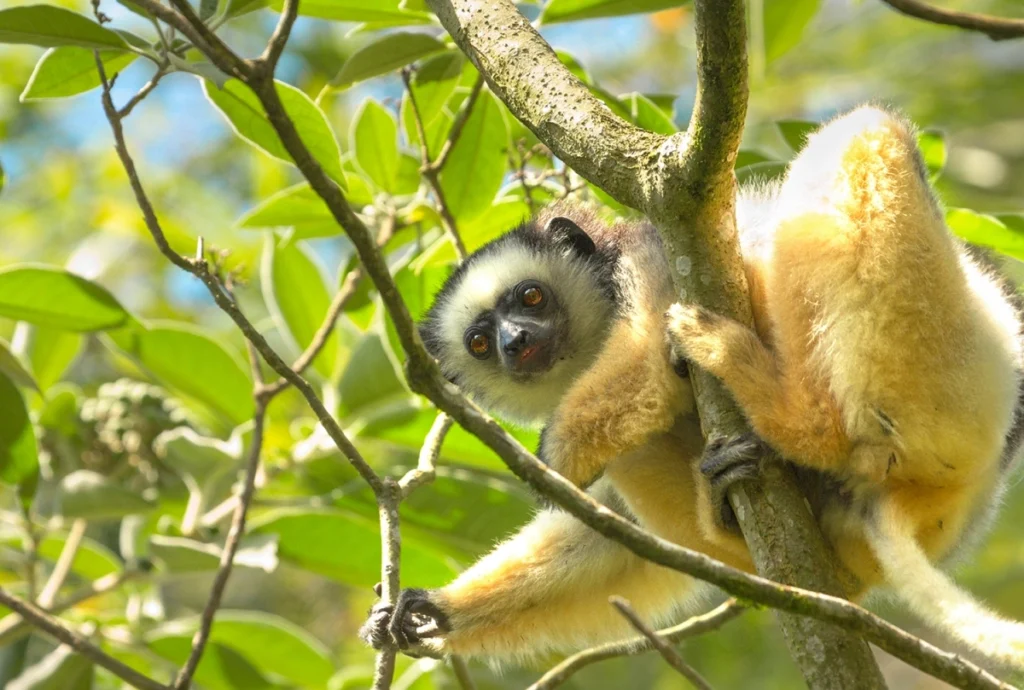
Tragically, the wildlife of Tsinjoarivo-Ambalaomby is threatened by intense human activities, most notably slash-and-burn forest clearance for agriculture. Additional major issues include wildfires, illegal logging, and gold mining. Through strategic support to our local partner SADABE, together with DREDD (the government authority for forests in Madagascar) and regional environmental authorities, we’ve implemented measures to combat the multiple threats facing Tsinjoarivo-Ambalaomby. We awarded a Conservation Action Rapid Patrol Grant to fund increased “mixed brigade” patrols composed of members from DREDD, SADABE, the Gendarmerie Nationale, and local community members. These patrols have yielded tangible results, including the apprehension of criminals engaged in illegal activities such as logging and mining. Through increased conservation enforcement, we’ve effectively curtailed deforestation and unauthorized mining within the reserve. Additionally, our extensive community engagement initiatives have educated and mobilized local residents, fostering a deeper commitment to conservation in the area. While we celebrate these accomplishments, our work is far from over. Conservation Allies remains dedicated to preserving Madagascar’s rich natural heritage, and we continue to collaborate with our partner SADABE to step up mixed brigade patrols across Tsinjoarivo-Ambalaomby Protected Area to ensure the Diademed sifaka and many other species have a home for the future.
A bold “zero deforestation” commitment for Ankarafantsika National Park

Ankarafantsika National Park contains 820 plant species with an endemism rate of 89.3% (meaning they are highly unique to this particular area), including three families of plants that are found only in this park. The park is also home to 37 species of mammals, 70 reptile species, 14 amphibian species (including the Critically Endangered Ankarafantsika Stub-toed Frog), plus the Critically Endangered Coquerel’s sifaka and Golden-brown mouse lemur. Three species of scorpions are only found in Ankarafantsika. From an ecosystems service perspective, Ankarafantsika National Park is the single most important Protected Area in Madagascar as it is a critical water tower that feeds the second most important rice basket in the country— rice being the staple diet for the nation. Tragically, this vital home for wildlife and critical water tank for thousands of rice growers is in danger. In just the past decade, Ankarafantsika National Park has lost almost one-quarter of its forest cover according to Global Forest Watch, including a further 1-2% forest loss in 2023. The main pressures include cutting down trees for timber and charcoal production, which in turn has produced degraded forests that are prone to fires set by local people in order to spread non-natural grasslands for cattle. The challenges here are immense but the stakes for biodiversity and people could not be higher. Conservation Allies has supported efforts at this Park for more than 10 years, but in recent years has increased support to our coalition of partners – Association Fosa, Planet Madagascar, and Madagascar National Parks. The major outcome of the two-day meeting was a collective commitment to zero deforestation— significantly stepping up funding for mixed brigade park protection and law enforcement patrols to stop illegal activities— by the 100th anniversary of the park in 2027.
Unique Andean Cloud Forest Reserve Expands by 445 Acres

Managed by our partner Fundación Cambugán, the Cambugán Protected Forest serves as a crucial habitat for endangered fauna, including the elusive Andean bear, and Ecuadorian squirrel monkey, as well as many endemic plant species. Enveloped by fog on a daily basis, this forest has a research station, allowing conservation research to prosper within this area of Ecuador. The work to safeguard the most biodiverse areas in the world is far from finished. Fundación Cambugan is continuously working to expand protections to more of Ecuador’s forests. It requires a collective effort from all, and each individual contribution counts towards ensuring the longevity of these invaluable ecosystems. With your support, we can continue our mission of supporting our partners in protecting and conserving these vital habitats for generations to come.
Major New Protection for the Chocó Biodiversity Hotspot

Perhaps the planet’s most diverse and unique treasure trove of wildlife is the little known and often overlooked Chocó biological hotspot. This narrow swathe of rainforest is sandwiched between the Pacific coast and high Andes, averaging just 50 miles wide while extending 600 miles from western Colombia to northwestern Ecuador. Covering less than 50,000 square miles (smaller than the State of New York), these lush rainforests are the wettest on earth and contain the highest concentrations of endemic biodiversity found on any continent. Unfortunately, for many decades, the conservation of this region has been overlooked. As a consequence, it remains significantly under-protected (less than 5% is under strict protection) with few controls preventing the large-scale deforestation that is destroying these rainforests at an unprecedented rate. Many endemic birds, plants and amphibians in the Chocó biological hotspot are at risk of extinction. Within this biogeographical region lies the Department of Chocó— a regional province covering almost half of the entire Chocó hotspot of western Colombia. Just 3.7% of the Chocó department land area is strictly protected, with only three small National Parks located along the coast and highest peaks. Yet, the most at-risk, range-restricted species are concentrated in the wettest mid-elevation rainforests between 3,000 to 7,000 feet. The persistent cloud cover and precipitation in this area provides crucial biotic and physiological features to make it a melting pot of unique biodiversity. For example, over 50 bird species and 2,000 orchid species are restricted to this region. Conservation Allies partner, Fundación ProAves, has been active in this region for over 20 years, having established nine nature reserves targeting strict protection for the hotspot’s most endangered species. One of these reserves, named “Las Tangaras,” was established in 2012 within the municipality of El Carmen de Atrato. Its creation followed a biodiversity expedition that unveiled various unique amphibian species for scientific study, including the identification of the endangered Chocó Vireo and Gold-ringed Tanager. Subsequently, ProAves secured support to purchase private forested lands earmarked for new cattle ranches, establishing the first protection of subtropical rainforest in the Chocó department. In recent years, the Reserve has been under intense pressure following the discovery of significant gold deposits around the reserve and a proposed Chinese-owned hydroelectric project. Overwhelmed by gold-miners, ProAves worked with the Regional Autonomous Corporation for the Sustainable Development of Chocó (CODECHOCÓ) to declare the Las Tangaras Reserve as a Regional Natural Park, thereby ensuring permanent protection by the state. In January 2024, CODECHOCÓ made a historic announcement, officially designating Las Tangaras Regional Natural Park, safeguarding 5,722 acres of pristine subtropical rainforest. This declaration represented a significant milestone, marking the department’s first-ever Regional Park and its first officially protected area in nearly four decades. Moreover, Las Tangaras Regional Park stands out as the first Regional Park featuring a dedicated birding and ecotourism lodge. It ranks among the top five most bird-rich sites in Colombia, boasting an impressive 557 species, which equates to over 1 in 20 bird species found worldwide. The historic declaration of Las Tangaras Regional Natural Park was a collaboration between Fundacion ProAves and CODECHOCÓ, with support from American Bird Conservancy, Conservation International, ASOCARS, and Conservation Allies.
Increased Ranger Patrols in Southeast Madagascar See Major Reduction in Threats for Protected Area
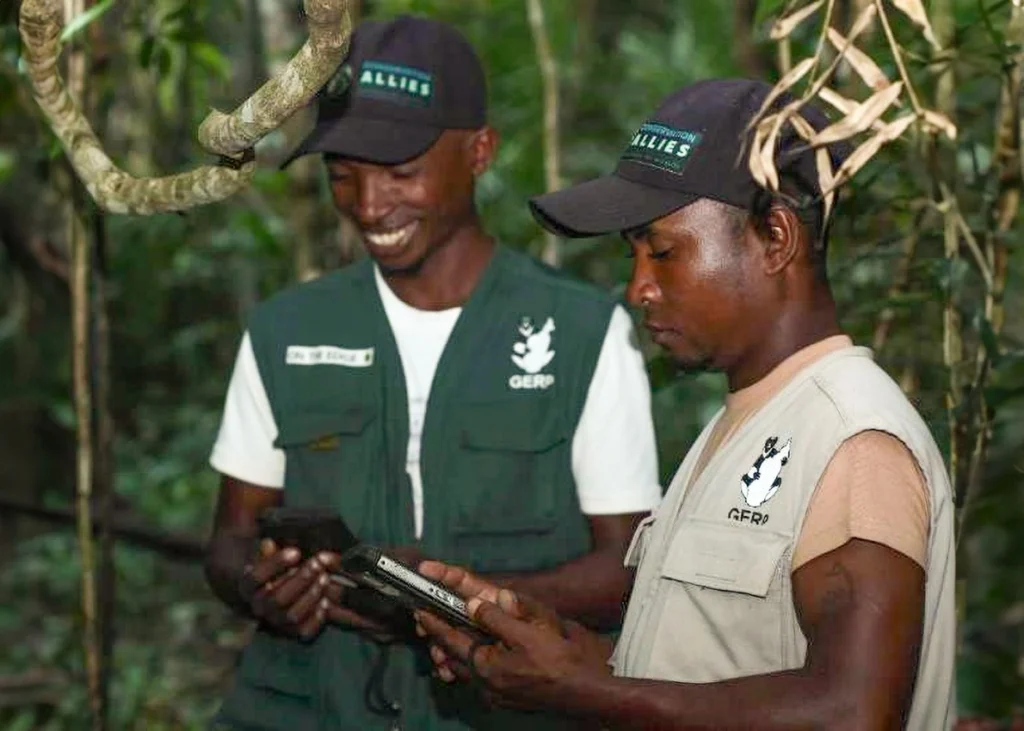
One of those key sites, the 14,331 acre Efatsy Manombo Special Reserve in southeast Madagascar, consists of unique rainforests and is home to seven species of lemurs, including the Critically Endangered Gray-headed lemur and James’ sportive lemur, both of which are found only in this reserve. Almost no native forest survives in this region outside of strictly protected areas, and pressure to clear forests for timber and charcoal is immense. It is imperative that we protect what remains. With the 2023 dry season from July to December bringing heightened risks of fires and deforestation, Conservation Allies provided a Conservation Action grant to GERP to increase patrols in Efatsy Manombo Special Reserve. GERP was able to scale their efforts, with seven equipped patrol teams covering over 1,450 miles in the most high-risk areas. Their goal was to prevent imminent threats and apprehend perpetrators undertaking destructive activities. Importantly, GERP documented a steep decline in pressure in 2023 as compared to previous years. For example, in 2022 they documented 133 illegal charcoal kilns, while only 74 were observed in 2023. Additionally, illegal logging violations dropped by 400%, with only 64 cases and a total of 6.42 acres cleared in 2023 (17 times lower than the 111.2 acres cleared in 2022). The sharp reduction in threats demonstrates that increased Reserve protection through patrolling teams working with law enforcement works to save wildlife in the face of even the greatest challenges. We are proud to support the work that the GERP team is doing to conserve the biodiversity of Madagascar. Featured photos are property of GERP
New Bird Species Found in Colombia’s Cloud Forests: Discovery of the El Dorado Antipitta
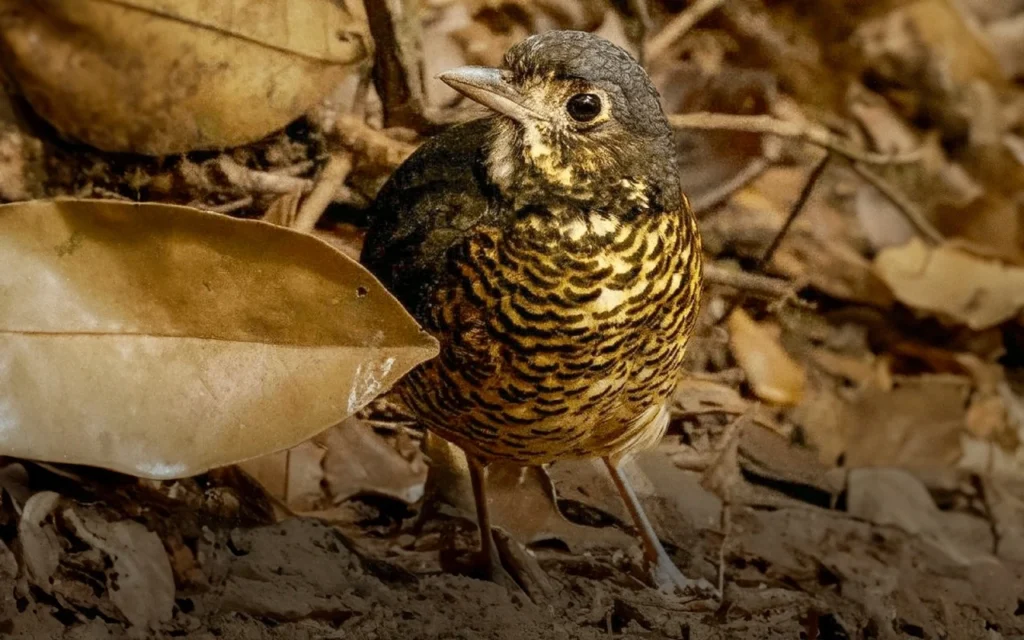
“This truly is a remarkable species discovery, not only because this large terrestrial bird eluded thousands of birders and ornithologists for decades, but that it further accentuates the global importance of the El Dorado ProAves Reserve and nearby pockets of surviving natural forest that are the last sanctuaries for this species and so many other endemic and endangered species.” Paul Salaman, President of Conservation Allies It is extremely rare to find a new species of bird nowadays. Just three new species were described globally in 2023. Colombia is the world’s #1 country for birds with over 1,979 bird species recorded, and yet, new species can still be found there. This exciting discovery further highlights the global importance of the 3,200 acre El Dorado ProAves Reserve for biodiversity conservation. With support from Conservation Allies, ProAves protects over 20 endemic bird species and hundreds of other species of amphibians, orchids, and reptiles restricted to the subtropical and montane forests of the reserve and the Sierra Nevada de Santa Marta mountain range. Alongside the atmosphere of celebration, there are valid concerns about the future of the El Dorado antpitta. The bird’s habitat is currently threatened by deforestation, made worse as climate change drives people to seek refuge from hotter areas of the country. The discovery of the El Dorado antpitta emphasizes the crucial role of protected areas like the El Dorado ProAves Reserve in preserving Comobia’s biodiversity, much of which is still unknown.
These researchers had to swim through rivers to protect Peru’s biodiversity
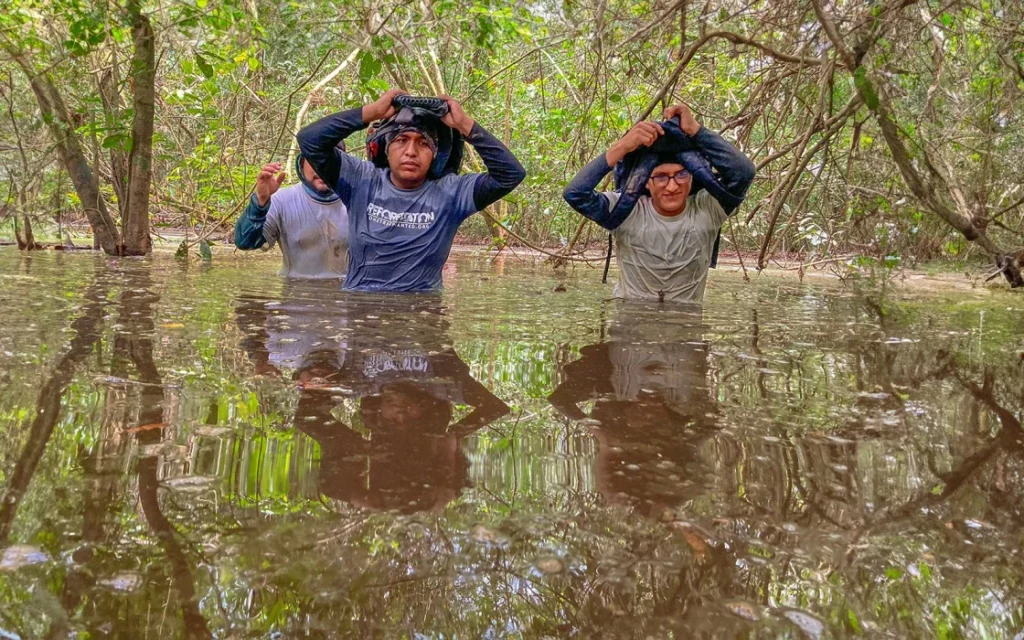
In the dense jungles of the Peruvian Amazon, conservation efforts often face challenges as diverse as the biomes they work to protect. Conservation Allies partner, Kawsay Biological Station, is a Peruvian biodiversity conservation non profit, situated in the buffer zone around the Tambopata National Reserve, that specializes in Spider monkey research. Small, local nonprofits like Kawsay often find themselves underfunded, navigating treacherous landscapes, both literal and financial, in their work to protect their region’s wildlife. They must compete with large, internationally recognized conservation organizations for support— an ongoing uphill battle. However, the story of Kawsay is a testament to the transformative power of adequate support and funding. Imagine researchers having to swim across a raging river, their equipment precariously balanced on their backs, just to access vital research and patrol areas. This was the reality for the dedicated team at Kawsay Biological Station until August 2023, when a grant from Conservation Allies made it possible to construct a bridge spanning the river. Construction of the bridge was recently completed, allowing Kawsay staff and volunteers to cross the river safely so they monitor wildlife and carry out essential conservation activities without risking their lives. Moreover, the construction of a workstation (also funded by a grant from Conservation Allies) near the research area has been a game-changer for Kawsay. Previously, researchers had to trek nearly 4 miles back to the main station at night and return to the research site the next morning. This logistical challenge consumed valuable time and limited the effectiveness of their patrols and research efforts. With the new workstation in place, equipped to store essential gear and provide shelter for researchers, Kawsay has significantly increased its operational efficiency. Researchers can now spend the night closer to the field site, maximizing their presence in the area and enhancing their ability to detect and respond to threats such as hunting and logging activities. The impact of these infrastructural improvements extends far beyond convenience. By enabling Kawsay to operate more effectively in the field, the grant has improved scientific understanding of the wildlife of the region, which will better future conservation strategies for animals such as the Endangered Black spider monkey. This success story underscores the importance of supporting lesser-known, but highly effective, conservation non profits like Kawsay Biological Station. By providing them with the resources they need to overcome challenges and realize their vision, we can play a vital role in preserving our planet’s biodiversity for future generations.
After Missing For Over A Century, This Friendly Mammal Has Been Rediscovered
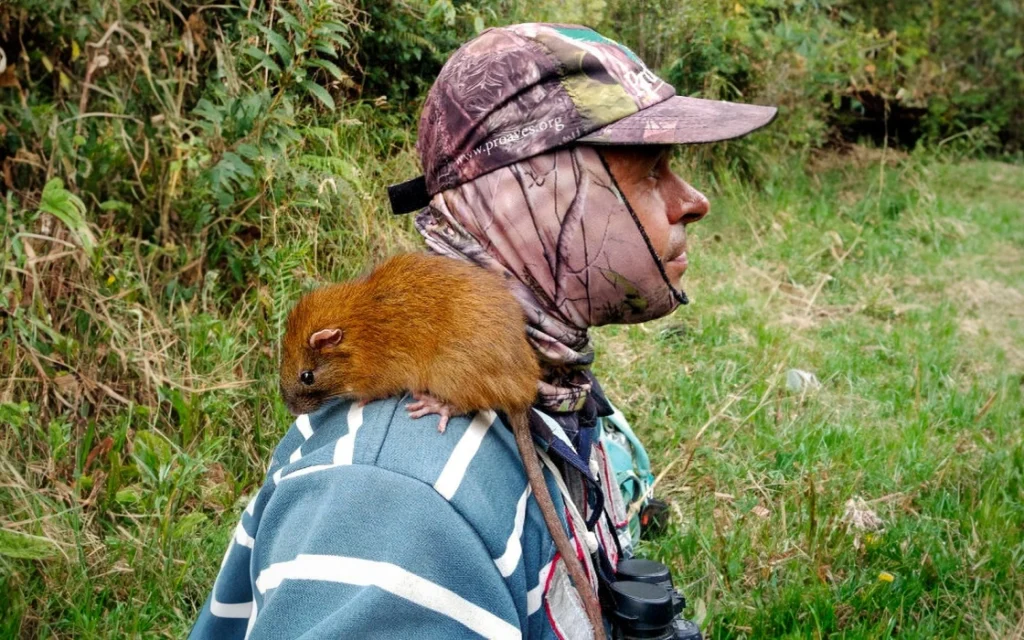
The Colombian Bamboo Toro, also known as the White-tailed olalla rat, was first described in 1879. For nearly 150 years it has remained elusive, with only 17 records from the Colombia Andes and a solitary record from Ecuador. Its enigmatic nature has shrouded it in mystery, with limited information available about its behavior and habitat. However, the recent encounter by Sergio Cruz, a ranger for Conservation Allies partner ProAves Foundation, has provided a rare glimpse into the world of this elusive creature. “I was undertaking surveys in the reserve when, around 2 pm at 3,430 meters elevation, I saw this mammal down the trail feeding on bamboo and grass,” recounts Sergio Cruz. “Little by little, I got closer and closer. It showed absolutely no concern for me, and despite its large size and being a wild animal, it let me take photos until it actually came to me and climbed on me! You cannot imagine my surprise and joy!“ Sergio Cruz, ProAves Foundation Ranger The Colombian Bamboo Toro is characterized by its distinctive features, including soft, long hair and an exceptionally long tail with a bold whitish tip. Its bright reddish-brown body contrasts with a whitish belly, making it a striking presence amidst the lush landscape of the Andes. Despite its rarity, this remarkable mammal has forged an unexpected bond with humans, offering hope for its conservation. Small mammals play a crucial role in maintaining the delicate balance of ecosystems. As seed dispersers, pollinators, and prey for larger predators, they contribute to the health and stability of their habitats. The Colombian Bamboo Toro, with its specialized diet and habitat preferences, occupies a unique niche within the Andean cloud forest ecosystem. The fondness of the Colombian Bamboo Toro for bamboo thickets within high Andean cloud forests highlights the ecological importance of these habitats. However, these fragile ecosystems face mounting threats from clearance for farming and the impacts of climate change. By safeguarding the Colombian Bamboo Toro and its habitat, we can protect not only a single species but an entire ecosystem teeming with life. The rediscovery of the Colombian Bamboo Toro underscores the critical need for conservation action. ProAves Foundation, in collaboration with Conservation Allies, is committed to studying this remarkable species to assess its population and implement effective conservation strategies. By leveraging scientific research, community engagement, and habitat protection initiatives, we can ensure the survival of the Colombian Bamboo Toro and other endangered species. The Loro CoroniAzul ProAves Reserve, where the rediscovery took place, holds significant importance as an Alliance for Zero Extinction site for the Critically Endangered Fuertes’s Parrot. This designation signifies its global significance for endangered species and habitats, emphasizing the need for continual and intensive conservation efforts in the region. Just 13 miles northeast of the this reserve and the Colombia Bamboo Toro sighting, in the same high Andean cloud forest, Conservation Allies is continuing to support ProAves in their work of building a major new ecolodge at the Loro Fuertesi ProAves Reserve, which will provide easier access and is fast becoming a popular destination to see the spectacular Fuertes’s Parrot.
Igniting Change: Saving Madagascar’s Ankarafantsika National Park
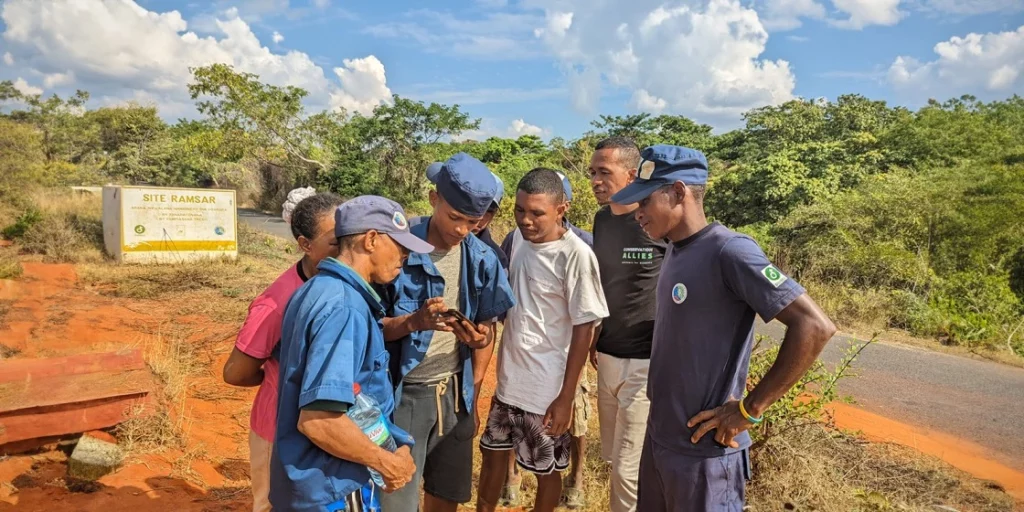
Ankarafantsika National Park has long suffered from rampant wildfires (started by humans), selective logging, illegal palm frond collecting, and agricultural expansion. It is home to hundreds of endemic and threatened species, including the Critically Endangered Coquerel’s Sifaka. Amidst the pressures faced by Ankarafantsika’s wildlife, collaborative efforts between FOSA and key organizations including Madagascar National Park (MNP), Durrell Wildlife Conservation Trust , and Planet Madagascar have begun yielding promising results for forest conservation of the area. This collaborative approach ensures a comprehensive and multi-faceted strategy to address the diverse array of threats facing Ankarafantsika’s forests. FOSA’s origins are forged from 25 years of research and conservation efforts by the local community around Ankarafantsika National Park under the guidance of Distinguished Professor Luke Dollar of Catawba College, and with the support of Conservation Allies. FOSA is driven by local residents who care about their National Park, showcasing a unique blend of grassroots activism, science-based conservation actions, and strategic partnerships. FOSA originally focused on research and monitoring of the unique and highly threatened Fossa (locally known as “Fosa”) which is the largest mammalian carnivore on Madagascar and looks like a small cougar, led by Prof. Dollar. The association has expanded its scope to incorporate research, education, and patrols, including the establishment of women’s associations, a notable inclusion in Madagascar’s conservation landscape. With a primary emphasis on wildlife conservation, FOSA collaborates closely with MNP to combat threats such as forest fires, illegal logging, and habitat destruction. Their approach is characterized by intimate knowledge of the land, proactive patrolling efforts, youth engagement, and community outreach initiatives. Utilizing new technologies, including conservation drones and real-time satellite reports of deforestation and fires, FOSA and Conservation Allies staff identified the origin of wildfires that were ravaging the area. By using data analysis to improve patrol techniques, FOSA has been able to identify and apprehend more illegal activities within the Ankarafantsika, leading to significant progress in curtailing logging, wildlife poaching, and other abuses of nature. FOSA has led a majority of the forest patrols in Ankarafantsika since 2022, positioning them as the major force defending the National Park. The effectiveness of FOSA’s forest patrols has greatly strengthened protective efforts of the Park and assisted MNP and other entities. FOSA’s nimbleness and community-led approach have enabled them to overcome challenges, allowing them to make swift and tangible progress in Ankarafantsika’s forest conservation. A notable shift observed in 2023 was the growing sense of respect local community members showed towards FOSA’s forest patrol teams. Their work has fostered a sense of ownership and responsibility among locals for forest conservation. Additionally, the simple fact that FOSA is present in the area has begun to noticeably deter people from engaging in illegal activities that previously often went unchecked. FOSA has become an example of what a community-based approach to conservation can achieve for National Parks. Their work has encouraged collaboration amongst other conservation non profits, innovation, and community engagement to safeguard the precious forest ecosystem of Ankarafantsika for future generations. By building on the successes of FOSA, Ankarafantsika stands poised to serve as a beacon of hope and resilience in the global fight for forest conservation.
Preserving Paradise: New Protection for Colombia’s Enigmatic Yellow-eared parrot

At the beginning of the twentieth century, the Yellow-eared Parrot thrived across the Colombian Andes. However, by the 1980s, relentless hunting and the logging of Quindío Wax Palms, the parrots’ primary habitat, for Palm Sunday rituals had brought both the parrot and the palm to the brink of extinction. In fact, the parrot was thought to be extinct until 1999, when ProAves Foundation launched an emergency campaign, led by Conservation Allies President Paul Salaman, to locate and protect any remaining Yellow-eared Parrot population. Their discovery of the last remaining flock in Roncesvalles, Tolima, marked the beginning of a concerted effort to address threats and bolster the population, which had dwindled to just 81 individuals. Central to the species’ recovery was the acquisition of private cattle farms in the parrot’s core breeding area. Establishing a protected sanctuary ensured safe nesting and breeding grounds, crucial for population growth. Recognizing the importance of this sanctuary, the regional environmental corporation CORTOLIMA declared the 11,406-acre area as the Loros Andinos Regional Natural Park, formally protecting the unique cloud forest and alpine tundra habitats in the Colombian Andes. The declaration of the Loros Andinos Regional Natural Park was made possible through collaboration with various organizations, including Conservation International, American Bird Conservancy, and ASOCARS. This milestone sets the stage for further declarations of ProAves Natural Reserves, crucial for protecting Colombia’s rich biodiversity. “ProAves is immensely proud to have helped CORTOLIMA declare the Loros Andinos Regional Natural Park on 26th December 2023 that safeguards the Quindío Wax Palm and the site that ensured the survival of the wonderful Yellow-eared Parrot. After 25 years, the Yellow-eared Parrot population exceeds 3,500 individuals and thanks to this Park today, this parrot is no longer considered at risk of extinction.” Sara Inés, Executive Director of ProAves Foundation In addition to the Yellow-eared Parrot, the park also safeguards habitat for other threatened species, including Fuertes’s Parrot, the Rufous-fronted Parakeet, the Golden-plumed Parakeet, and the Rusty-faced Parrot. Additionally, it preserves a diverse range of flora and fauna endemic to Colombia’s Central Cordillera. Over the past 25 years, the ProAves team faced numerous challenges and tragedies in their work to protect the Yellow-eared parrot, including the loss of ranger Gonzalo Cardonas, who was murdered defending the species. In light of such sacrifices, the permanent protection of the Loros Andinos Regional Natural Park stands as a beacon of hope in the fight to conserve endangered species. In a time where many species face uncertain futures, the recovery of the Yellow-eared Parrot in Colombia serves as a testament to the impact of dedicated conservation efforts. The establishment of the Loros Andinos Regional Natural Park highlights the potential to make a difference in preserving biodiversity, even in the face of great adversity.


